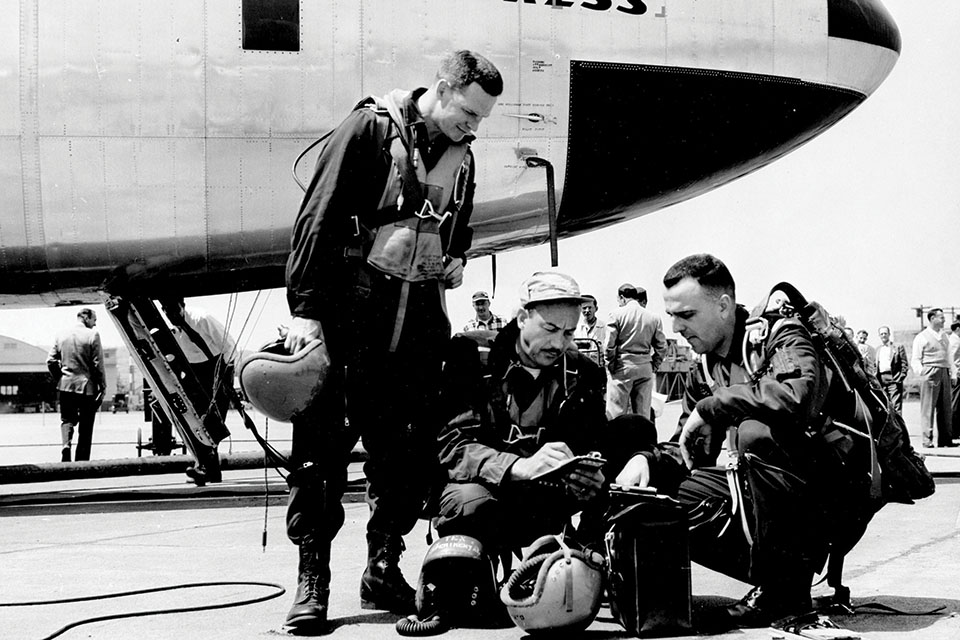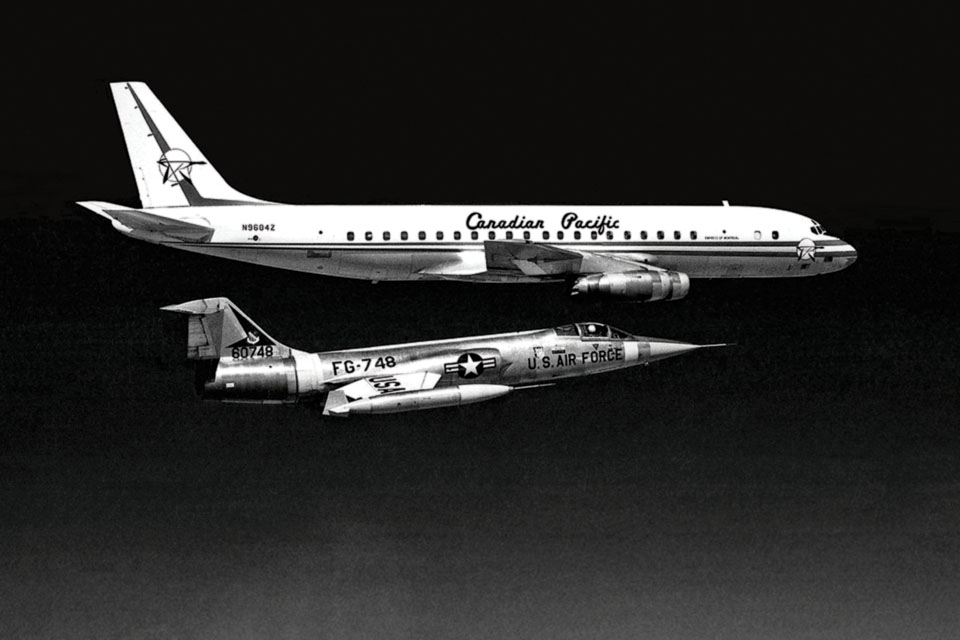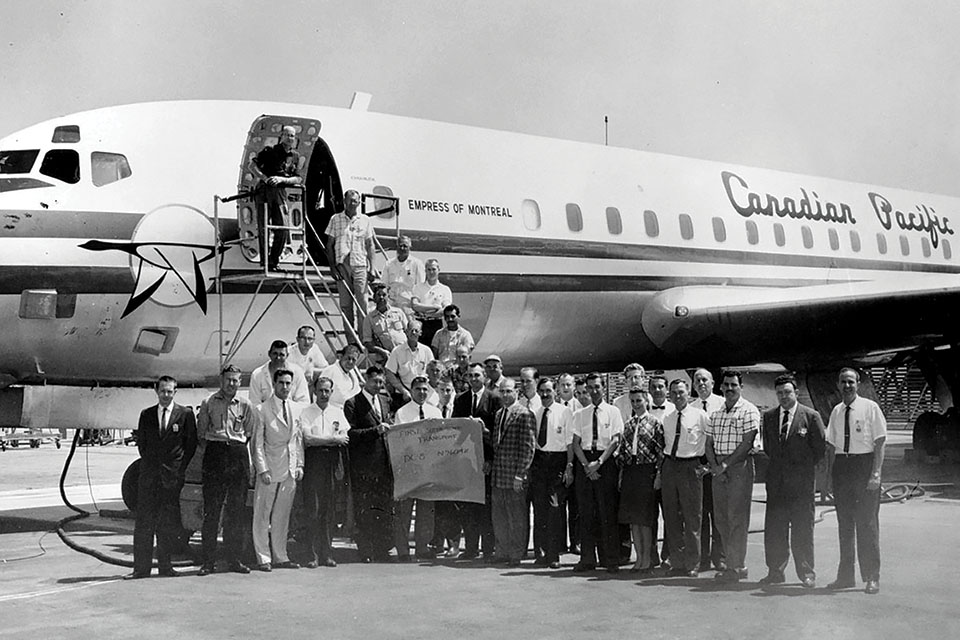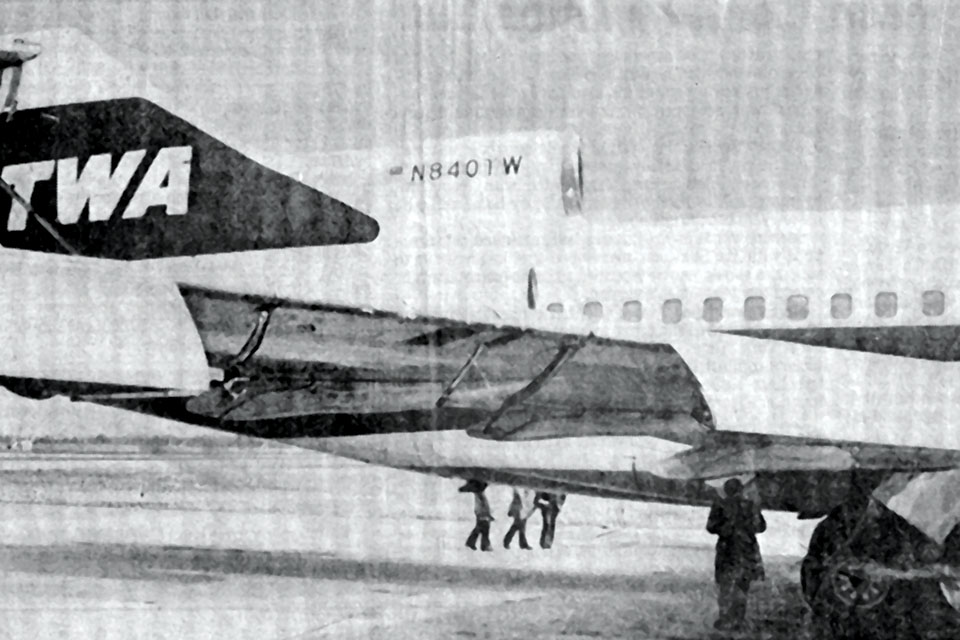I was guilty of this, I thought the "Concorde" was the first Airliner to break the Sound Barrier, I didn't know that a Douglas DC-8 "Greasy 8" broke it first. Shows what is incomplete in the history and what I know, LOL
One would expect an airplane slated for a record flight attempt to be prepped and flawless down to the last rivet, but before it even left the Douglas Aircraft plant in California the DC-8 chosen for this particular attempt was no longer factory-fresh. In an interview with aviation historian Bill Wasserzieher for a Douglas employee oral history project, flight test engineer Richard H. Edwards recalled, “The night before, at Long Beach, somebody had dinged the [wing leading-edge] slats and they didn’t work.” And during the preflight check Edwards damaged the trailing-edge flaps, banging one on a flight crew workstand inadvertently left under it.
Without slats and flaps, low-speed handling was going to be tricky. Luckily, this crew wasn’t aiming for a low-speed record. Pilot William Magruder told them, “Well, we can take off with no flaps and the airplane will be all right…if we don’t lose an engine.”

Douglas had a lot riding on the flight. Over the previous decade Boeing had just about locked up the market for military bombers with its B-47 and B-52. Now with Boeing’s new 707 jet airliner (first flown in December 1957), the company was seeking to do the same to the commercial market. Douglas had gained a huge head start in the airliner business with its legendary prewar DC-3, but its new four-jet DC-8 had not flown until six months after the 707 took off.
Magruder had been copilot in 1958 on the DC-8’s maiden flight. As an Air Force test pilot and engineer he had flown everything from the North American F-86 Sabre and Martin B-57 Canberra to the Douglas C-124 Globemaster II and B-52 Stratofortress. He had flown with Chuck Yeager, the first man to exceed the speed of sound in level flight, and Alvin M. “Tex” Johnston, who had famously flown a Boeing 367-80 (707 prototype) through a double barrel roll, before joining Douglas in 1956. “He was well known in the industry and very articulate,” recalled Edwards, “well educated, with a lot of new ideas.”
His newest idea was to grab headlines for the DC-8 by making it the first commercial airliner to break the sound barrier. “Very smart,” agreed Edwards, “get it out there, show the airplane can survive this and not fall apart. Boeing will never try it [with the 707] because they don’t want to be second.”
The DC-8 was decidedly subsonic, designed to cruise at 542 mph at 35,000 feet (Mach .82). Douglas put a whole team of engineers to work on the math. Edwards recalled, “They had to determine the pushover load factor, the dive angle, to be sure they got to Mach 1.01 at a rather high altitude, so the airspeed wouldn’t be that high up there.”
On the designated day, August 21, 1961, Magruder and Edwards were joined at the Douglas plant in Long Beach by copilot Paul Patten and flight engineer Joseph Tomich. The aircraft chosen for the flight was a new DC-8-43, no. N9604Z, the 130th built. The Series 40 was the first airliner in the world powered by turbofans, for improved efficiency and less noise and smoke.
Resplendent in the red and white colors of its new owner, Canadian Pacific Air Lines, and emblazoned with its new name, Empress of Montreal, the DC-8 looked fine with its dinged slats and flaps closed—nobody could tell the bird was slightly crippled. “We took off with flaps up,” admitted Edwards, “which is kind of a no-no because at takeoff thrust, you can’t control the airplane if it loses an engine with flaps up—there’s an interlock on the rudder.”

The test was to be conducted about 80 miles to the north, over Askania Tracking Range at Edwards Air Force Base in the California desert. On the way up the DC-8 rendezvoused with a two-seat North American F-100F Super Sabre camera ship and a Lockheed F-104 Starfighter chase plane (flown by Magruder’s old friend Yeager) provided by the USAF Flight Test Center, which also supplied a weather balloon to verify speed and atmospheric data. Over the southern tip of Rogers Dry Lake, Magruder leveled out at 50,090 feet, in itself a record for a civil airliner at that time. “The thing that impressed me the most was the dark, black sky,” recalled Edwards. “I’d never seen anything like that.”
From that altitude, the rest of the flight would be downhill all the way. It was Edwards’ job to know when they crossed the magic number. “The Mach number itself isn’t used in a dive as a target because it’s much more accurate to use airspeed,” he explained. “So every thousand feet I would read off to Bill the airspeed at the next altitude. As we were coming down, I was talking almost all the time because at a descent rate of 500 feet per second, every two seconds we were 1,000 feet lower. Looking out the window—which I stopped doing—it looked like it was straight down.”
As the airliner neared Mach 1 it compressed the air moving over it into shock waves, capable of tearing a poorly designed aircraft to pieces. “At .96 Mach it buffeted for a while,” remembered Edwards, “…and a little above .96 it went away.”
But shock waves can also affect control surfaces, to the point of reducing or even reversing pilot input. “I had mounted some cameras in the middle of the airplane, shooting out each window,” Edwards recalled. “I wanted to catch the chase airplanes out there, but I never saw the chase airplanes in the pictures. But it did show the ailerons flapping up as the shock wave left—I think it was about .97 Mach. They went up about five degrees, I think—both sides, fortunately.”
Magruder held the yoke steady as Empress made history. “In the dive, at about 45,000 feet, it went to Mach 1.01 for maybe 16 seconds,” said Edwards. In fact, at 41,088 feet the DC-8 recorded Mach 1.012, 660.6 mph at that altitude. By then Magruder was already starting to pull out, but as Edwards recalled, “The recovery was a little scary.”
When Magruder eased back on the yoke to pull out of the dive, the plane barely responded. The elevators, not designed to operate at such speed, could not overcome the supersonic airflow. The DC-8 was out of control, hurtling earthward at just over Mach 1, and in less than a minute would impact the desert floor…unless it tore apart in midair first.
“Well, I’ll use the stabilizer,” said Magruder. Besides the elevators on their trailing edges, the DC-8’s horizontal tailplanes (also called stabilators) could rotate as one piece—at least, at subsonic speeds. At 39,614 feet the DC-8 hit a maximum true airspeed of 662.5 mph.

“The stabilizer wouldn’t run….because of the load,” recalled Edwards. In the high-speed pullout, with the airliner ever so slightly nose-up to the wind, the motor controlling the tailplane angle literally couldn’t overcome the air pressure under the tail.
“What [Magruder] did, because he was smart, is something that no other pilot would do,” said Edwards. “He pushed over into the dive more, which relieved the load on the stabilizer.”
It was unconventional thinking—increase the dive rate to pull out of a dive? But as soon as Magruder stopped trying to pull out, the airliner “straightened out” into the wind, and the reduced air pressure allowed the tailplane motor to function and the stabilators to bite into the airflow. They “recovered at about 35,000 feet,” Edwards noted, no doubt with a sense of relief.
In the course of the dive the DC-8 had covered almost 15 miles, to the southern tip of Rosamond Dry Lake. “We were all smiles,” said Edwards. “We weren’t frightened, but we were more or less happy that we had got there.”
In just that one flight, Empress of Montreal had set altitude, payload and speed records for commercial transport aircraft. The speed record stood until broken by a Soviet Tupolev Tu-144 SST in June 1969. Each crewman received a $1,000 bonus from Douglas, and the Society for Experimental Test Pilots awarded Magruder the Iven C. Kincheloe Trophy for outstanding professional accomplishment in flight testing.Canadian Pacific took delivery of Empress of Montreal that November. With a small plaque on the forward bulkhead attesting to its place in history, it served for almost 20 years, logging 24,268 flights for a total of 70,567 hours in the air. In May 1981 it was sold, and at Opa Locka Municipal Airport north of Miami, Fla., scrapped. It never broke the sound barrier again.
DC-8 no. N9604Z was the first airliner to exceed Mach 1, but not the last. The Concorde and Tu-144 made supersonic passenger flight seem routine (at least, until a series of crashes and economic considerations caused their retirement). Today most commercial airplanes like the Boeing 787 and Airbus A350 cruise around Mach 0.85 to 0.89, while smaller corporate jets from Cessna, Gulfstream and Bombardier routinely cruise above Mach 0.90. It’s not unheard of, however, for subsonic airliners to exceed Mach 1 (761 mph at sea level), at least in terms of ground speed.
In February 2018 a Norwegian Air 787-9 heading from New York to London caught a ride on the jet stream over the Atlantic. Dreamliners had previously reached 776 mph with a tailwind, but this one made the crossing in 5 hours and 9 minutes, topping out at 799 mph. And a year later, a Virgin Atlantic 787-9 out of Los Angeles on its way to London also caught the jet stream 35,000 feet over Pennsylvania, achieving a ground speed of 801 mph. Because the high-speed wind was carrying the jets like boats on a river, these airplanes did not exceed Mach 1 as measured by local airspeed. At least one other non-SST airliner, however, did break the speed of sound…though not intentionally.

In April 1979 TWA Flight 841, a Boeing 727-31 en route from New York City to Minneapolis-Saint Paul, Minn., deployed the no. 7 leading-edge slat on its starboard wing while cruising at Mach .816, 39,000 feet over Saginaw, Mich. Slats being low-speed, high-lift devices, the resulting asymmetrical lift and drag immediately threw the airliner into a starboard roll. It entered into an uncontrolled spiral dive and plunged about 6 miles in 63 seconds, according to the flight recorder doing two complete 360-degree rolls and breaking the sound barrier in the process. At that velocity the wind tore off the exposed slat, the captain dropped the landing gear to put maximum drag on the airframe and the crew regained control with about 8,000 feet to spare. They made a successful emergency landing in Detroit.
Despite damaged landing gear, parts of flaps and wing spoilers missing and a host of other damage including a cracked cabin window, the passengers and crew suffered only minor injuries. The aircraft was returned to service a month later. A National Transportation Safety Board investigation attributed the incident to incorrect operation of the slats by the crew. (A rumor had circulated that slightly deploying slats and flaps at cruising speed increased the 727’s lift with no increase in drag, yielding greater fuel efficiency. According to the NTSB, the crew had deployed all the slats, but due to air loading no. 7 failed to retract.) The crew strongly denied wrongdoing, pointing out seven previous incidents of single-slat extensions by 727s.

The NTSB appears to not be as competent at their job as one would hope, especially in the aircraft field. Lots of reviews of aircraft crashes by outside experts show ineptitude, and a bias toward manufacturers and against crews.
ReplyDeleteFrom the golden age of aviation....when the men involved clanked when they walked.
ReplyDeleteInteresting...
ReplyDelete